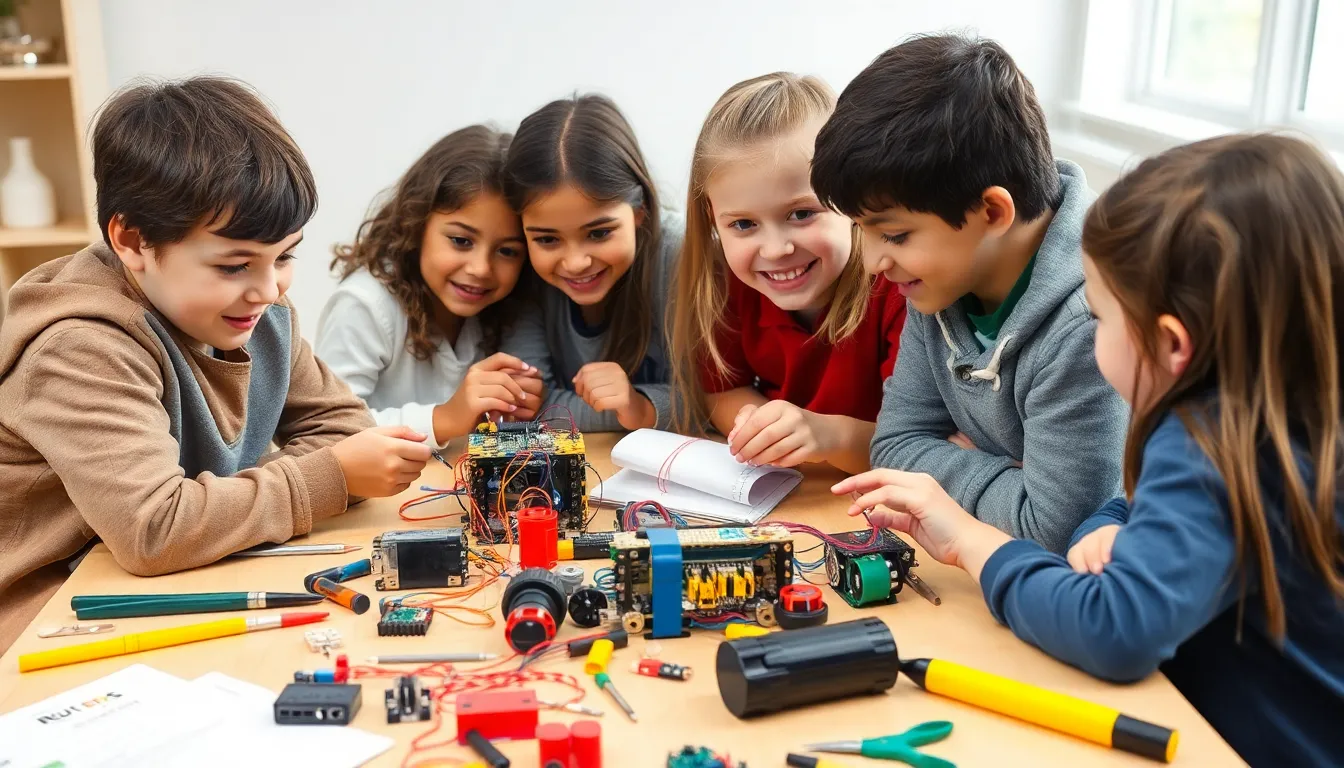In a world where robots might take over, why not get ahead of the game with STEM robotics kits? These little bundles of joy aren’t just toys; they’re gateways to innovation, creativity, and maybe a future where your child can outsmart the family dog. Imagine your kid building a robot that can fetch snacks—now that’s a win-win, right?
Table of Contents
ToggleOverview of STEM Robotics Kits
STEM robotics kits combine science, technology, engineering, and mathematics principles to create engaging learning experiences. They empower children to design, build, and program robots, enhancing their problem-solving skills. Each kit typically includes various components like motors, sensors, and building materials that facilitate hands-on learning.
Learning is interactive and fun with these kits, which cater to different age groups and skill levels. For instance, younger children may use simple, colorful blocks, while older kids tackle more complex systems with coding challenges. Educational institutions often incorporate these kits into their curricula, recognizing the value of practical applications in teaching.
A diverse range of robotics kits exists in the market, from basic construction sets to advanced programmable robots. Popular brands such as LEGO Mindstorms, VEX Robotics, and Snap Circuits offer options that engage students in a unique way. These brands also frequently update their product lines, ensuring that kits remain relevant with technological advances.
Classroom settings prove ideal for utilizing STEM robotics kits, as they promote collaboration among students. Groups can engage in projects that require teamwork, directly addressing real-world engineering problems. Hands-on projects create an exciting environment that captivates learners and inspires innovation.
Parents and educators often appreciate the long-term benefits of these kits. Skills developed through robotics education, such as coding and critical thinking, align with future career demands. Increased interest in STEM fields among children results from these engaging activities, ultimately fostering a new generation of innovators.
Key Features of STEM Robotics Kits

STEM robotics kits offer numerous features that enhance learning and engagement. They combine education and play, making the acquisition of skills enjoyable and effective.
Educational Benefits
Robotics kits promote critical thinking and problem-solving abilities. Children engage with concepts like engineering and programming in real-world contexts. Through trial and error, they learn resilience and creativity. Programs often align with educational standards, ensuring students gain relevant knowledge. Exposure to basic coding languages prepares them for technological careers, while teamwork in construction projects fosters collaboration skills. Overall, these kits create a solid foundation for future STEM education.
Components and Tools
Robotics kits usually include a variety of components like sensors, motors, and controllers. Younger children may work with simple blocks, while advanced sets challenge older kids with complex tools. Many kits also provide detailed instructions and tutorials, helping users navigate their building and programming journey. Interactive software often accompanies the hardware, enabling real-time coding and debugging. This diverse range of components allows for customization and creativity, encouraging students to explore different concepts and applications in robotics.
Top STEM Robotics Kits in the Market
Numerous STEM robotics kits exist, each offering unique features and learning experiences. Here are three top options available today.
Kit 1: Overview and Features
LEGO Mindstorms EV3 stands out for its versatility, appealing to both beginners and advanced users. This kit includes a programmable brick, motors, and sensors, enabling kids to construct various robotic models. The accompanying software features an intuitive drag-and-drop programming interface. With compatibility across different devices, users can easily engage with their projects. Many educational institutions incorporate LEGO Mindstorms into their curricula, highlighting its effectiveness in teaching engineering principles.
Kit 2: Overview and Features
VEX Robotics IQ provides a comprehensive platform for hands-on learning and collaboration. This kit features a modular design, allowing users to build complex robots without extensive prior knowledge. It includes various components, such as motors, sensors, and structural pieces. The VEXcode programming software supports blocks and text-based coding, catering to diverse skill levels. Schools frequently use VEX Robotics IQ for robotics competitions, fostering teamwork and problem-solving abilities among students.
Kit 3: Overview and Features
Snap Circuits is ideal for younger learners, making electronics fun and accessible. This kit includes colorful snap-together components, allowing kids to create functioning circuits effortlessly. Users can experiment with various projects, including alarms and lights, fostering creativity and critical thinking. Detailed instruction guides support independent learning, ensuring clarity at every step. Its hands-on approach engages children while building a solid foundation in STEM subjects.
Factors to Consider When Choosing a Kit
Selecting the right STEM robotics kit involves several critical factors. First, consider the target age group of the child. Kits designed for younger children often include simpler components and visual instructions, promoting accessibility and engagement.
Next, evaluate the kit’s complexity and educational goals. More advanced kits cater to older students and provide greater challenges. Applauded brands like LEGO Mindstorms and VEX Robotics present kits that showcase a gradual learning curve, ensuring compatibility with various skill levels.
Another essential factor is the quality of materials included in the kit. Durable parts enhance playtime and provide a practical learning experience. Enthusiasts appreciate kits with reliable components, as this greatly affects the longevity of the projects.
Explore the available programming options as well. Interactive software can make learning coding more enjoyable, fostering creativity. Kid-friendly interfaces, like the drag-and-drop feature in LEGO Mindstorms, simplify initial programming experiences.
Look into the support resources provided with the kits. Access to online tutorials and customer service can significantly benefit young learners. Such resources help clarify complex concepts and resolve challenges encountered during building.
Collaborative opportunities may enhance the learning experience, too. Some kits encourage teamwork, allowing children to work alongside friends or classmates. Group projects stimulate communication skills and deepen understanding of engineering concepts.
Assess expandability when evaluating a kit. Some kits allow users to purchase additional parts to evolve projects. Enthusiasts appreciate such adaptability as it promotes continued interest in robotics and engineering.
Lastly, always prioritize budget considerations. Kits vary widely in price, so establishing a budget helps find an option that fits financial constraints without sacrificing quality.
STEM robotics kits are invaluable tools for nurturing the next generation of innovators. They seamlessly blend education with play while promoting critical thinking and problem-solving skills. As children engage with these kits, they not only learn essential STEM concepts but also develop resilience and creativity through hands-on experiences.
With various options available, parents and educators can find the perfect kit to match a child’s age and skill level. Investing in these robotics kits lays a strong foundation for future learning and career opportunities. Embracing this exciting approach to education can spark a lifelong interest in technology and engineering, paving the way for future success in an increasingly tech-driven world.


